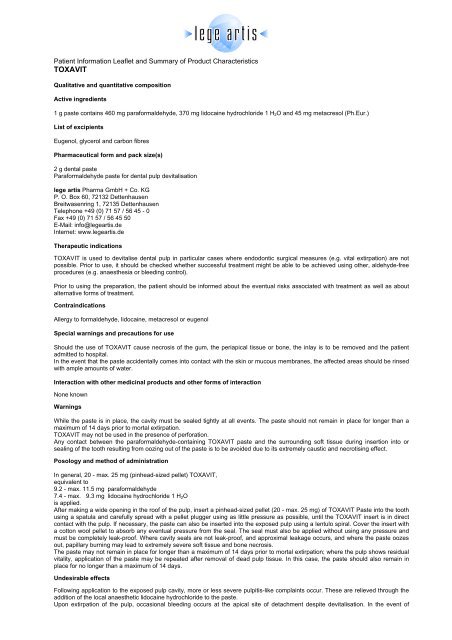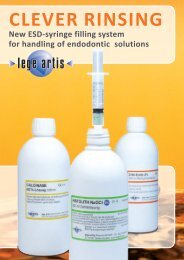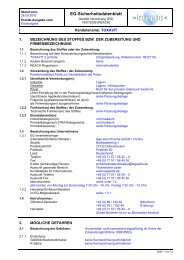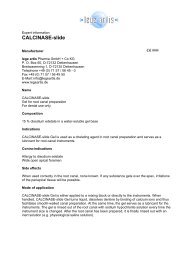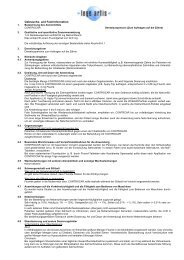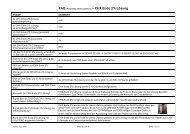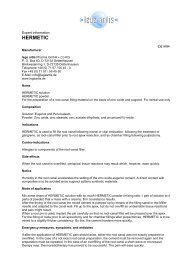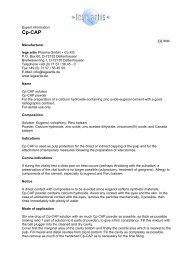TOXAVIT - Lege artis
TOXAVIT - Lege artis
TOXAVIT - Lege artis
Create successful ePaper yourself
Turn your PDF publications into a flip-book with our unique Google optimized e-Paper software.
Patient Information Leaflet and Summary of Product Characteristics<br />
<strong>TOXAVIT</strong><br />
Qualitative and quantitative composition<br />
Active ingredients<br />
1 g paste contains 460 mg paraformaldehyde, 370 mg lidocaine hydrochloride 1 H2O and 45 mg metacresol (Ph.Eur.)<br />
List of excipients<br />
Eugenol, glycerol and carbon fibres<br />
Pharmaceutical form and pack size(s)<br />
2 g dental paste<br />
Paraformaldehyde paste for dental pulp devitalisation<br />
lege <strong>artis</strong> Pharma GmbH + Co. KG<br />
P. O. Box 60, 72132 Dettenhausen<br />
Breitwasenring 1, 72135 Dettenhausen<br />
Telephone +49 (0) 71 57 / 56 45 - 0<br />
Fax +49 (0) 71 57 / 56 45 50<br />
E-Mail: info@lege<strong>artis</strong>.de<br />
Internet: www.lege<strong>artis</strong>.de<br />
Therapeutic indications<br />
<strong>TOXAVIT</strong> is used to devitalise dental pulp in particular cases where endodontic surgical measures (e.g. vital extirpation) are not<br />
possible. Prior to use, it should be checked whether successful treatment might be able to be achieved using other, aldehyde-free<br />
procedures (e.g. anaesthesia or bleeding control).<br />
Prior to using the preparation, the patient should be informed about the eventual risks associated with treatment as well as about<br />
alternative forms of treatment.<br />
Contraindications<br />
Allergy to formaldehyde, lidocaine, metacresol or eugenol<br />
Special warnings and precautions for use<br />
Should the use of <strong>TOXAVIT</strong> cause necrosis of the gum, the periapical tissue or bone, the inlay is to be removed and the patient<br />
admitted to hospital.<br />
In the event that the paste accidentally comes into contact with the skin or mucous membranes, the affected areas should be rinsed<br />
with ample amounts of water.<br />
Interaction with other medicinal products and other forms of interaction<br />
None known<br />
Warnings<br />
While the paste is in place, the cavity must be sealed tightly at all events. The paste should not remain in place for longer than a<br />
maximum of 14 days prior to mortal extirpation.<br />
<strong>TOXAVIT</strong> may not be used in the presence of perforation.<br />
Any contact between the paraformaldehyde-containing <strong>TOXAVIT</strong> paste and the surrounding soft tissue during insertion into or<br />
sealing of the tooth resulting from oozing out of the paste is to be avoided due to its extremely caustic and necrotising effect.<br />
Posology and method of administration<br />
In general, 20 - max. 25 mg (pinhead-sized pellet) <strong>TOXAVIT</strong>,<br />
equivalent to<br />
9.2 - max. 11.5 mg paraformaldehyde<br />
7.4 - max. 9.3 mg lidocaine hydrochloride 1 H2O<br />
is applied.<br />
After making a wide opening in the roof of the pulp, insert a pinhead-sized pellet (20 - max. 25 mg) of <strong>TOXAVIT</strong> Paste into the tooth<br />
using a spatula and carefully spread with a pellet plugger using as little pressure as possible, until the <strong>TOXAVIT</strong> insert is in direct<br />
contact with the pulp. If necessary, the paste can also be inserted into the exposed pulp using a lentulo spiral. Cover the insert with<br />
a cotton wool pellet to absorb any eventual pressure from the seal. The seal must also be applied without using any pressure and<br />
must be completely leak-proof. Where cavity seals are not leak-proof, and approximal leakage occurs, and where the paste oozes<br />
out, papillary burning may lead to extremely severe soft tissue and bone necrosis.<br />
The paste may not remain in place for longer than a maximum of 14 days prior to mortal extirpation; where the pulp shows residual<br />
vitality, application of the paste may be repeated after removal of dead pulp tissue. In this case, the paste should also remain in<br />
place for no longer than a maximum of 14 days.<br />
Undesirable effects<br />
Following application to the exposed pulp cavity, more or less severe pulpitis-like complaints occur. These are relieved through the<br />
addition of the local anaesthetic lidocaine hydrochloride to the paste.<br />
Upon extirpation of the pulp, occasional bleeding occurs at the apical site of detachment despite devitalisation. In the event of
insufficient diffusion or inadequate release of formaldehyde, vital tissue fragments can remain in the canal and cause considerable<br />
pain.<br />
If formaldehyde extravasates from the apex and reaches the furcation area or side canals or leaking filling edges, inflammation or<br />
necrosis of periapical tissue, surrounding bone or the gums may result.<br />
When used on milk-teeth, damage to the dental germ of the subsequent adult tooth may occur during the early stages of<br />
development (before mineralisation is complete) in extremely rare cases. Systemic effects cannot be ruled out.<br />
There are no findings on this method of application and local carcinogenicity.<br />
Local and systemic allergic reactions are possible.<br />
Special precautions for storage<br />
<strong>TOXAVIT</strong> must always be stored tightly closed in a refrigerator (2 - 8 °C).<br />
<strong>TOXAVIT</strong> Paste is to used up within 6 months after the first opening.<br />
<strong>TOXAVIT</strong> should not be used after the expiry date, which is printed on the label and on the package.<br />
The container must be closed tightly after each use and placed in a refrigerator.<br />
Date of revision<br />
January 2011<br />
Additional information for professionals:<br />
Pharmacy-only ("For dental surgery use only")<br />
Pharmacological properties<br />
<strong>TOXAVIT</strong> Paste contains paraformaldehyde. Paraformaldehyde is a formaldehyde polymer with a varying number of monomers. Its<br />
depolymerisation to formaldehyde is determined by the environment it is in and the prevailing temperature thereof. Formaldehyde<br />
binds to cell proteins and brings about denaturation of proteins and a ceasing of vital cell functions. The onset of this effect is slow.<br />
In tissue, vasodilatation and increased capillary filling is first of all observed. Tissue dies as a result of endothelial lesions<br />
accompanied by haemorrhaging and oedemas, as well as a loss of nuclear staining and hyaline softening of connective tissue, the<br />
development of hyaline and blood cell thrombi and finally total interruption of microcirculation. The extent of changes depends on<br />
the concentration of formaldehyde and the time it is allowed to take effect.<br />
Bacteriostatic or bactericidal effects are achieved in micro-organisms through an appropriate change in protein molecules.<br />
There are no definite differences in concentration in respect of an antibacterial and tissue-damaging effect.<br />
There are no details pertaining to the rate of depolymerisation and the concentration of formaldehyde in the tooth. It can be<br />
concluded that, from the devitalisation of the whole pulp that occurs in most cases, sufficient amounts of formaldehyde are released.<br />
Lidocaine relieves or prevents eventually occurring pulpitis-like pain. Metacresol helps the paste to adhere to pulp protein. The<br />
paraformaldehyde in the paste reacts with pulp protein to form a leathery mass, which, on the whole, is easy to extirpate.<br />
Eugenol renders the paste soft and suitable for application.<br />
Toxicological properties<br />
Formaldehyde has cytotoxic, membrane-toxic and neurotoxic effects, and irritates mucous membranes considerably (particularly<br />
eyes, upper respiratory tract, nose).<br />
The allergenic potential of formaldehyde is relatively high. Both early type reactions (angioneurotic oedema) and delayed type<br />
reactions (contact dermatitis) have been described. As an allergen, paraformaldehyde can also lead to allergic reactions of the early<br />
type.<br />
In vivo micronucleus tests performed on mice have usually yielded negative results for paraformaldehyde; there have, however, also<br />
been positive results. In vivo tests on mammalian systems have produced contradictory results.<br />
Going on epidemiological studies and long-term animal testing, it is at present likely that the carcinogenic effect results mainly from<br />
the chronic inflammatory process, which, depending on the concentration thereof, is caused by long-term exposure to<br />
formaldehyde, and is not so much based on a direct, genotoxic mechanism.<br />
Numerous studies have been performed on various species of animal to investigate the acute toxicity of lidocaine. Signs of toxicity<br />
have manifested themselves in the form of CNS symptoms. Other signs thereof have included lethal cramp attacks. The toxic<br />
(cardiovascular or CNS systems, cramp) plasma concentration for lidocaine in humans is specified at 5 µg/ml to > 10 µg/ml blood<br />
plasma.<br />
Mutagenicity tests have yielded negative results for lidocaine. There are, however, indications that a metabolite of lidocaine, 2,6xylidine,<br />
produced in rats and possibly in humans, might have mutagenic effects. This was also observed in in vitro tests where this<br />
metabolite was used in extremely high and almost toxic concentrations. In addition, 2,6-xylidine was seen to have a tumorigenic<br />
potential in a carcinogenicity study performed on rats, which were exposed transplacentally to 2,6-xylidine and treated for 2 years<br />
with the metabolite upon being born. In the course of this highly sensitive test system, malignant and non-malignant tumours,<br />
particularly in the nasal cavity (ethmoturbinalia) were observed after extremely high doses. As it cannot be ruled out with sufficient<br />
certainty that these findings are of relevance as far as humans are concerned, lidocaine should not be administered in high doses<br />
over long periods of time.<br />
Upon correct use of this medicinal product, metacresol and eugenol are not expected to have any relevant mutagenic potential.<br />
There are no clinically relevant data on the reproduction toxicity of <strong>TOXAVIT</strong>.<br />
Further notes<br />
Pregnancy<br />
As there are insufficient data on its use in pregnant women, <strong>TOXAVIT</strong> is to be used with caution during pregnancy.<br />
Lactation<br />
As there are insufficient data on its use in breast-feeding women, <strong>TOXAVIT</strong> is to be used with caution during lactation.<br />
0022119/Stückzahl0111/Bestelldatum


